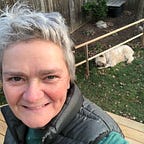This refugee crisis, similar to all others, leaves a disproportionate number of kids in distress and we have no plan to resolve it
Like the rest of the world, I have been spending a lot of time thinking about the Russian invasion into Ukraine. I’ve read some beautiful articles about the history of the region, about the government but, most importantly, about the people. Inspiring as these stories are, it continually makes me think about the reverberating nature of cruelty. To leave your country under your own volition is one thing, but to be forced out? That requires real strength to reconcile and often leaves unseen or unacknowledged damage.
As a teacher I was witness to wars, civil wars, and various forms of oppression for too many years. Moreover, I never had to leave my classroom to witness the catastrophic cost caused by the malice of others. With the news of each emerging conflict, I knew that we would soon be welcoming another wave of refugees to our school. And I knew that the painful baggage of their experiences would permeate and echo throughout the school, often uncovering old wounds felt by others.
Our school was, for many years, the #1 school in Canada where kids had been in the country for less than five years. For many of them, the airport, the ride to the neighbourhood and the walk to the school were the only experiences of Canada they had known. To top it off, they often had very little to no English, money or cultural connections.
Thankfully, our campus was a true Canadian mosaic and the nearly 850 students could easily find someone who spoke their first, second or third language. We even had a list in the office to cross-reference languages so that in an emergency, every person in our community could communicate. People representing over 50 countries and 60 languages could be found within our walls when I was there. Simply amazing.
However, the downside to this mosaic culture is the inevitable interaction of rival forces coming together again. Accepting new safety without residual anger is virtually impossible. To feel safe again, we must deal with the events and emotions that caused us to feel unsafe in the first place. For refugees, everything and everyone in their lives has been impacted. And now, here in front of you, is a person from the other end of the now existential conflict.
The most important lessons that I ever taught or received happened in these moments. In this inner-city school, I found the most compassionate and resilient young adults who bore physical and mental scars of another life and yet could smile with ease in the hall or argue in class with sophisticated perspectives. However, being aware of the simmering anger or resentment and trying to redirect the negative towards the positive was a constant in my class management.
The constant and inhumane dislocation of families, broken and bruised, pushes kids beyond their limits.
It is not the politicians or the wealthiest who are left to struggle in a refugee crisis; we know they have made themselves incredible safety nets and are sailing off in mega-yachts to the great beyond — or so it seems. It is the average person who fights every day to have a better chance. A chance. Not a guarantee. Try explaining that dichotomy to a kid who left everything behind and now stands in a foreign land with empty pockets and must swallow unforgettable pain.
Somalia
Bosnia and Herzegovina
Afghanistan
Iraq
Iran
Yemen
The Congo
Kosovo
Eritrea
Bangladesh
Zimbabwe
Syria
Colombia
These countries are only a few from which I heard stories of persecution, escape and loss that would make so called freedom convoys crumble with shame. As a theatre teacher, it was always my objective to allow young adults the opportunity and space to heal through sharing stories as much as each person was comfortable expressing. Growing up is hard enough but to add the incredible stress of escape and resettlement, I cannot even fathom.
I can still see the anger on the face of someone who was racially targeted at our borders and was able to express how it felt on stage. Or the cloaked resignation on another’s face who was forced to be a child soldier and was then asked to show empathy for others in a group assignment. Or the smiling face of one who had no idea how badly she had been affected by the Chernobyl disaster. And, I can still feel the pain of a twin who felt that she was unnecessary in her family’s new Canadian life.
These teens, and so many others, cobbled together disparate events trying to make sense of their upended lives. They spoke, as characters, about the money, land and friends that had vanished, the frustration of communication and the dawning realization that the struggle to reach Canada was really only their parent’s story. The refugee story. The story of displacement, mass movement and a lost world. A world that will perhaps never be seen again and the ache of forfeiting citizenship.
The constant and inhumane dislocation of families, broken and bruised, pushes kids beyond their limits. They do not yet have an adult understanding of conflict and we hope instead for resilience in place of understanding. Being open to hear those personal struggles in class is necessary — even if it hurts. Because, if we cannot break the cycle here, by allowing stories to be heard and acknowledged; and if we cannot accept the natural outflow of anger in a safe place, those unresolved moments will be sequestered and then surface at a future time and place that is inappropriate or harmful and cruelty will begin again.
Then, we will scratch our heads and say, ‘So-and-So always seemed so nice. I have no idea where that came from!’
